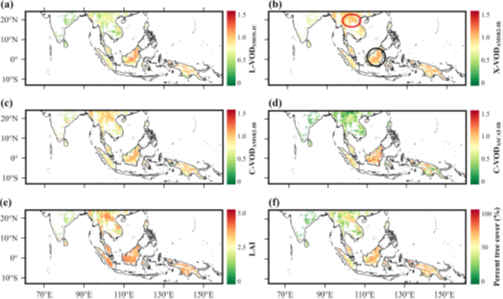August 1, 2023 | Remote Sensing of Environment
A collaborative research effort involving experts from China, France, the UK, and Denmark has delved into the intriguing changes happening in tropical Asia's lush landscapes. Specifically, they've been studying how carbon, an essential element in all living things, is shifting in this region.
Tropical Asia has been getting greener in recent years, but we haven't had a clear understanding of how this growth affects the carbon stored in plants. To solve this puzzle, the researchers turned to satellite technology. They used data from satellites equipped with both optical and microwave sensors to monitor the region's aboveground live biomass carbon (AGC) from 2013 to 2019.
Here's what they discovered:
- Effective Proxies: They found that certain satellite-based measurements, like LAI (Leaf Area Index), percent tree cover (PTC), and L-VOD (Vegetation Optical Depth measured in L-band), were closely connected to the distribution of carbon in plants. In other words, when these measurements increased, it often meant more carbon was stored in the vegetation.
- Satellite Advantages: Satellite technology, especially in X- and C-bands, was particularly good at capturing changes in carbon storage for areas with medium carbon density vegetation. However, it struggled to track carbon changes in places with high carbon density vegetation.
- Carbon Trends: Using L-VOD data, the researchers estimated that tropical Asia's forests and non-forest areas collectively stored more carbon in plants each year, at a rate of roughly 44 to 53 teragrams of carbon. The majority of this increase occurred in non-forest regions.
- Change Drivers: The study revealed some important trends. Non-forest areas in parts of India, China, and Vietnam experienced consistent carbon storage growth, while forests in Laos, Malaysia, and Indonesia lost carbon due to deforestation.
In essence, this research helps us understand how tropical Asia is managing its carbon resources. It shows that some regions are storing more carbon in plants, mainly outside of forests, while others are losing carbon due to deforestation. By using advanced satellite technology, we can track these changes and work toward more sustainable land use practices to protect our planet's vital carbon balance.
Read more: First assessment of optical and microwave remotely sensed vegetation proxies in monitoring aboveground carbon in tropical Asia





